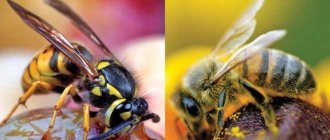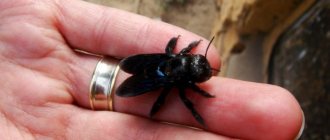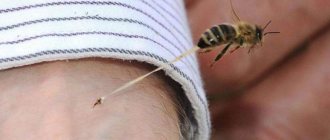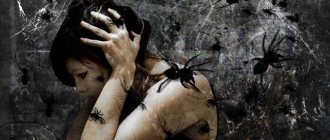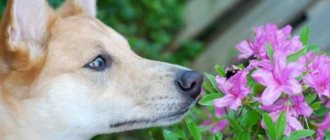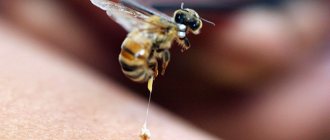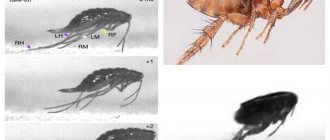Appearance
The common carpenter bee, or xylocopa species , is a large (up to 3-4 cm long) black bee that lives alone in the wild. There are bluish spots on the head and front of the body, the wings are also blue, with a violet sheen.
These huge fluffy insects (the body is covered with sparse dark hairs) look very unusual, a little scary due to their size and dark coloring, but they are definitely not without some visual attractiveness.
Description
What does a hornet look like? In appearance, this insect resembles a large wasp. In the photo of the hornet you can see a large head, on the back of the head of which the organs of vision are located.
The body sizes of insects vary from 20 to 25 millimeters. The abdomen is striped, the wings are thin, the jaws are pronounced and strong, the eyes are large. This is a type of large wasp; these insects inhabit the entire territory of Europe.
Their habitat:
- agricultural plots;
- forest areas;
- grove thickets;
- large shrubs.
They most often build nests under the roof of a veranda, toilet or gazebo, under window openings or stairs. The Asian hornet is not found in our area; this species is considered the most dangerous.
Habitat
You can meet xylocopa in a meadow, in a forest or field, in a garden and even in a park, but only if it is located in an ecologically clean area. Currently, the natural habitats of this insect are being destroyed: deforestation, pollution of fields, water, and air. First of all, this leads to a reduction in the number of black bees: for several decades this species has been considered rare and is listed in the Red Book of the Russian Federation.
The increasing number of cases of xylocopes appearing in our wooden dwellings is a bad sign, and this is not because the bee brings some inconvenience to people: it is an alarming signal about the negative changes that are happening to our unique Russian nature here and now.
Peculiarities
The insect builds nests in dead tree trunks, old, and sometimes not so old, wooden buildings; For this special habit the bee was nicknamed the carpenter. The blue bee also has a sting, and in this regard it is in no way inferior to its striped relatives: if necessary, a xylocop can sting very painfully, much more painfully than its smaller relatives. If you are bitten, you should remove the sting from the wound, as well as the insect venom, and treat the damaged area with a bactericidal agent.
It is worth remembering that carpenter bee venom is quite toxic, and if the swelling around the sting does not go away for a long time, contact a specialist. A sharp allergic reaction to insect venom is also possible - characteristic symptoms will appear almost immediately after the bite. In such a situation, you cannot hesitate; it is better to immediately seek medical help.
Common carpenter bee
The insect belongs to the Apidae family and the species of solitary bees. This particular species has relatively large dimensions - the body length reaches a maximum of 3 cm. In common parlance, a carpenter bee is called a xylocop or a tree nest. In total there are more than 500 species, which unite 30 breeds. Externally, most of them differ only in shades.
Individuals living in Russia are more reminiscent of shaggy flies with a black body and beautiful wings that have a blue-violet or blue sheen.
Carpenter Bee
Description of lifestyle and habitat
The wood bee gets its name from the fact that it makes a honeycomb home in dead wood, cutting multi-level nests with numerous cells, each of which will develop a larva.
Features of the separation grid and method of its manufacture
During “construction work” it makes sounds as if a modern drill was working. Sounds can be heard within a radius of several meters. The entrance to the monastery is always perfectly round and single, as if it had been drilled with a drill.
Since the nest is created more likely for the future generation, bee children can also use it, but this is not necessary. Typically, only a couple of individuals remain, or even one when the queen dies. To create housing is one of their basic instincts.
Creating a Nest
There are carpenter bees all over the Earth, but most have settled in the central and western parts of Europe, in the Caucasus. In Russia, solitary insects are found in the Stavropol and Krasnodar territories, the Central Black Earth region, the Volga region and other places where climatic conditions are similar.
Due to the fact that the blue bee's favorite nesting place is dead wood, it is most often found in summer cottages, near parks, forests and groves. Fences, old telegraph poles and other buildings made of this material are ideal shelters for it.
When choosing a location, the location of the food source plays a big role, but carpenter bees can fly many kilometers in search of food.
Important! The main activity of insects of this species occurs from May to September, in rare cases October, if the autumn is warm enough.
The diet is no different from the diet of ordinary bees: plant pollen, sweet fruits, etc. Collecting pollen, she smears it with her saliva and dilutes it with nectar stored in honey crops. Thanks to this, during a long flight, the collected items do not fall apart.
Bee saliva contains special microbes that instantly start the fermentation process and turn the product into bee bread. Adults and newly emerged larvae feed on it. But for the latter, the bees convert the substance into protein-rich royal jelly.
Reproduction
When a xylocopa builds a nest, it makes fairly deep tunnels in the wood, and then divides them into cells, using sawdust mixed with sticky saliva as a building material for partitions. The mother bee then fills each cell about one-third full with honey and lays her eggs on top of the nutrient bee. Then the insect closes its passage and flies away: this completes its parental duty, provided for by instinct.
The larvae develop in cells all summer. Eggs laid at the end of May are hatched by adult bees in the fall. Bees from later clutches fly out of their cells the following spring, having waited out the harsh winter in their cell-houses.
How to get rid
So, the carpenter bee itself is harmless, but only if it is far from populated areas. Otherwise, the insect becomes dangerous to humans: it makes a nest in a residential wooden house or destroys agricultural buildings.
As has already been said, these bees bite painfully, and if you suddenly do not notice your new neighbor in time (even despite her impressive, albeit for an insect, size), then you risk suffering both physical and material damage: a painful bite and pretty much eaten walls.
How to remove xylocopa?
For this, various methods are used, more or less effective:
- Pesticides against wasps and other large Hymenoptera. They can be in the form of powders, aerosols, gels, and so on. It is impossible to say which one is optimal: all of these remedies have their advantages and are effective when used correctly. In particular, agents such as carbaryl (Sevin) and boric acid are effective.
- Gasoline . It is very toxic and will undoubtedly kill bees and their larvae if poured into xylocope tunnels. But you should be extremely careful with this substance: firstly, it is flammable, and secondly, the human body’s reaction to gasoline is not much different from that of insects. So take care to protect your skin from getting gasoline on it, and your lungs from inhaling its toxic fumes. It is best to use a spray bottle.
- Finally, there are more humane (relatively) methods of dealing with carpenter bees: You can scare them away with loud noise , which they cannot stand (using a music center near their nest, turned on at full volume). The bravest ones can use a tennis racket and swat a couple of pests, striking fear into the hearts of others (bees, by the way, have no hearts).
Interesting Facts
Beekeepers around the world continue to try to tame the carpenter bee and turn it into an ordinary bee that brings honey. If this happens, beekeepers around the world will have a unique type of bee that will be virtually invulnerable.
But all attempts have not yet brought results: the bee develops and actively lives exclusively in its natural habitat. This species is also valuable because it is able to work actively even in bad, inclement weather. Neither rain nor wind can stop the carpenter bee from covering vast distances and obtaining pollen.
The bee has a reputation as a "loner". This is not entirely true. Despite the fact that each lives separately, each still maintains contact with the other bees. This is due to the reproductive instinct. As a rule, five to six females live in one territory and one male, who guards his territory.
When a new female appears in his zone, the male rises as high as possible and begins to make a loud sound, attracting the attention of the newcomer. If a strong buzzing has no effect, the male is able to climb into her nest and come back out
He does this as many times as it takes for the chosen one to pay attention to him.
If you find this bee within your home, you should take the necessary measures. But first, it’s worth clarifying whether the carpenter bee is included in the Red Book or not. The latest data from scientists suggests that the population of these unique individuals is rapidly declining.
To find the habitat of bees, it is worth remembering a few facts:
- the favorite habitat is dried soft wood;
- to build a nest, the insect chooses exclusively natural materials, so you should not look for the insect, for example, in furniture treated with paints and varnishes;
- monitor the movements of the bee in the spring, when young insects are looking for a place to build their own nest.
If detected, there is no need to completely eliminate insects. It is enough to “drive” them out of their homes using gasoline, agricultural poisons or ordinary water. You can also tightly wall up all the holes in the nest. Another interesting way is to treat the nest and nearby surfaces with citrus extracts.
Lemon, bergamot, lime, orange are suitable. Be careful when using chemicals. Use protective equipment. They will protect against chemicals and unexpected attacks by an angry bee.
Hardworking insects that pollinate plants and create sweet and healthy products have been known since prehistoric times. Acquaintance with bees began long before their domestication. Currently, entomologists identify more than 20 thousand species, among which there are very interesting specimens. Particularly notable is the carpenter bee - a bee of rare beauty and strength, capable of gnawing nests in wood.


